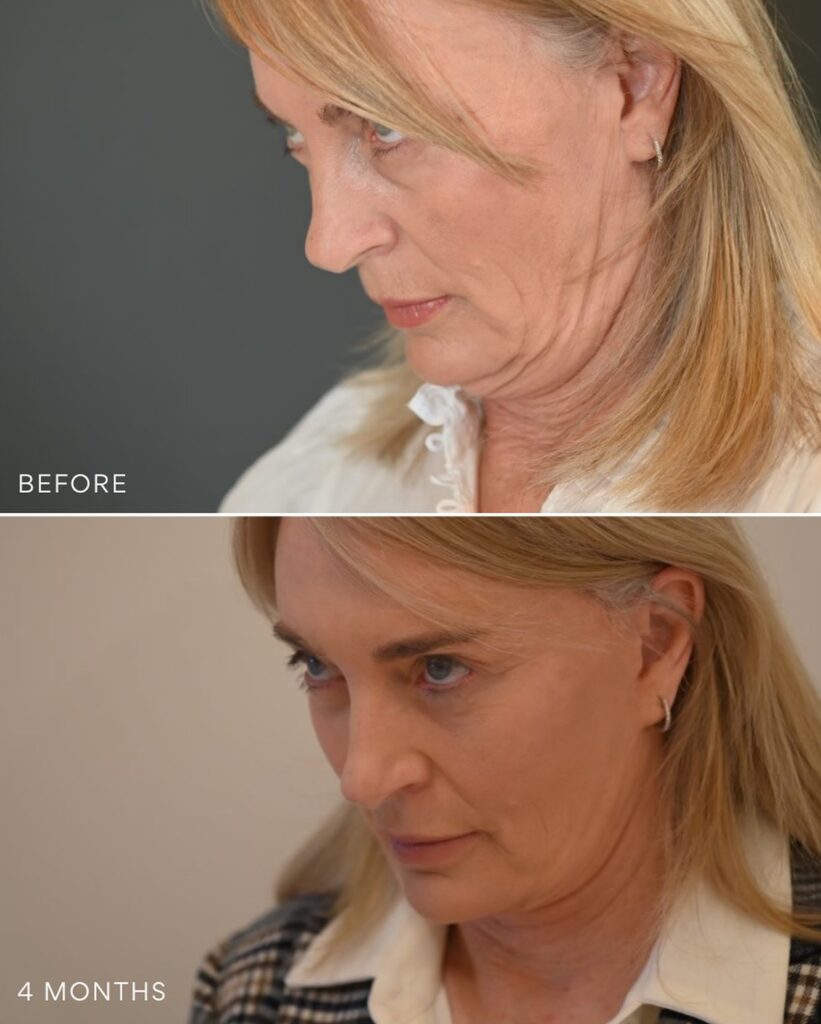How To Know If You’re A Good Candidate For A Neck Lift?
Model featured in photography

Disclaimer: Results vary and are illustrated as a guide only.
Due to the tissues in the neck being thinner than facial skin, for instance, it may be among the first in the body to show signs of ageing. It is unnecessary, but for some individuals, this has prompted them to explore treatments like a neck lift surgery.
While such procedures can address loose skin and wrinkles, being a candidate for surgery goes beyond perceived needs. Candidacy involves thorough evaluation steps, including referrals from a GP, Body Dysmorphic Disorder (BDD) screening, and comprehensive medical assessments to ensure patient safety. Understanding these necessary steps helps align expectations and ensures that individuals are informed when considering whether surgery is suitable for them.
1. Evaluate your goals and expectations.
Before considering a neck lift, it’s crucial to have realistic expectations. While the procedure can produce impressive results, it won’t halt the ageing process in the neck area. Ongoing maintenance and healthy habits are essential for long-term results.
2. Consider your health and medical history.
Good candidates for a neck lift should be in overall good health. It’s important to disclose your complete medical history to your surgeon, including any existing medical conditions or medications you’re taking. Obtaining a GP referral is required to ensure you’re in optimal health for the surgery and recovery. Additionally, undergoing a Body Dysmorphic Disorder (BDD) screening is vital to assess any underlying psychological factors and ensure that the decision for surgery is well-informed and based on realistic expectations.
3. Review your lifestyle and habits.
A healthy lifestyle contributes significantly to the success of a neck lift. Candidates should avoid smoking, as it can impair healing and increase the risk of complications. Maintaining a balanced diet, staying hydrated, and engaging in regular exercise can also improve your overall health and support the recovery process.
4. Understand the recovery process and potential risks.
Recovery from a neck lift involves downtime, swelling, and bruising. Be prepared for time off work and assistance with daily activities. Knowing what to expect helps you decide if you’re ready for the procedure and can manage the post-operative care. Additionally, it’s important to be aware of potential risks and complications associated with the surgery, so you can make an informed decision.
5. Consult with a qualified plastic surgeon.
Determining suitability for a neck lift requires a detailed evaluation by a qualified professional. It is essential to consult a licensed practitioner who can assess your health, discuss your concerns, and outline all aspects of the procedure, including recovery and potential risks, to support informed decision-making.
Plastic surgery should never be rushed, and feeling secure throughout the process is paramount. If you experience anxiety or hesitation, it is crucial to communicate this to your surgeon to ensure your comfort and readiness.
Disclaimer: At Artiste Plastic Surgery, our Plastic Surgeons led by Dr Jack Zoumaras have been trained to the highest possible degree. All surgery has risks and it is always advised to get a second opinion. Risks are very real and we cannot guarantee any result. Results are illustrated as a guide only. All risks are managed and any need for revision surgery or complications (1-5%) can be managed by our specialist plastic surgeons.
Any statements on how you will feel is based on Level V Evidence:
Level V: How you will feel after plastic surgery varies between individuals, depending on psychological and physical factors. Our internal research is based on how patients in our practice feel after surgery.
The blogs are not a substitute for a medical consultation and do not form as part of the doctor to patient relationship.
SHARE THIS ARTICLE
Oct08
Upper vs Lower Eyelid Surgery: What’s the Difference
Disclaimer: At Artiste Plastic Surgery, our Plastic Surgeons led by Dr Jack Zoumaras have been trained to the highest possible degree. All surgery has risks and it is always advised ...
Oct08
Blepharoplasty for Hooded Eyes: Before & After Guide
Disclaimer: At Artiste Plastic Surgery, our Plastic Surgeons led by Dr Jack Zoumaras have been trained to the highest possible degree. All surgery has risks and it is always advised ...
ABOUT ARTISTE
Artiste Plastic Surgery is an Award Winning Specialist Plastic Surgery practice led by internationally trained Dr. Jack Zoumaras, Plastic Surgeon and Peer Reviewed Face Surgeon
Artiste offers the latest Cosmetic Surgical Procedures of the Face, Breast and Body, inspired from leading centres around the world.
STAY IN THE LOOP
Enter your email address below to receive updates on new articles and VIP access to promotions and special offers.
FOLLOW US ON INSTAGRAM
